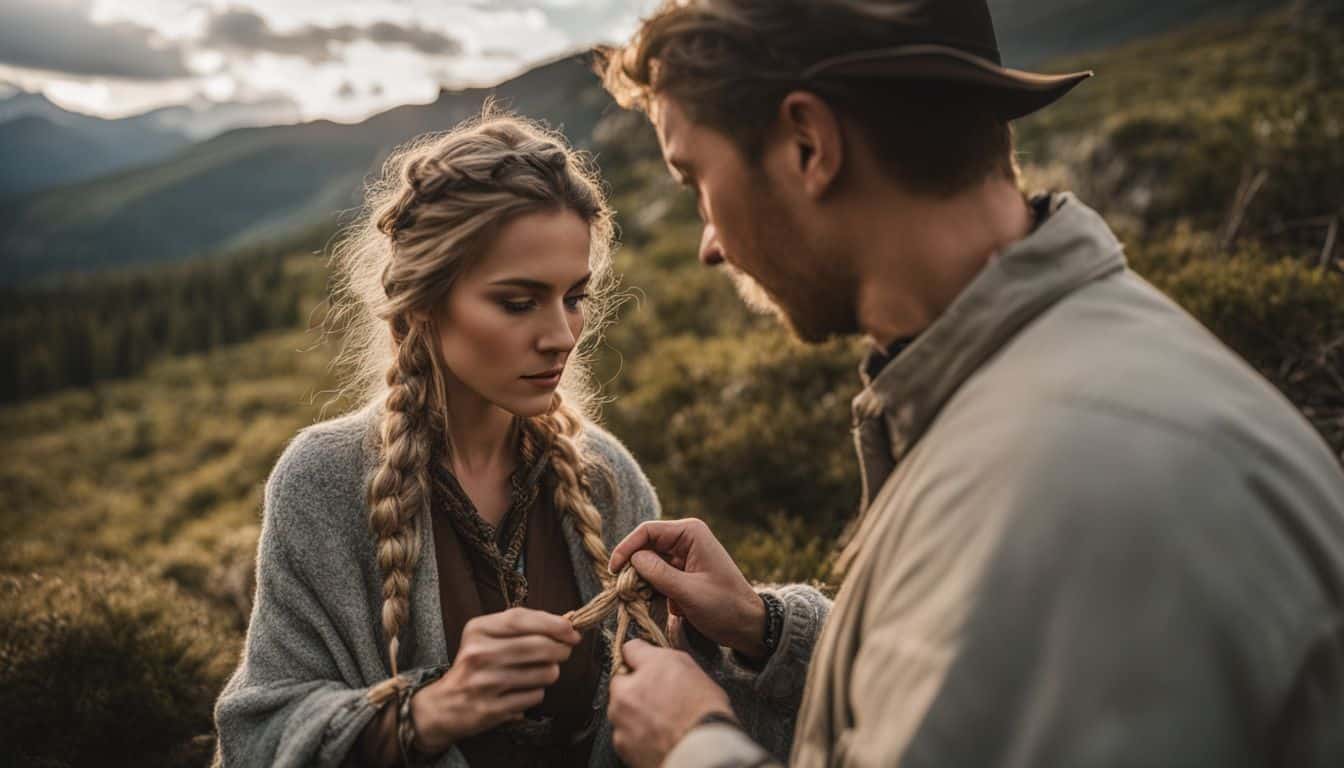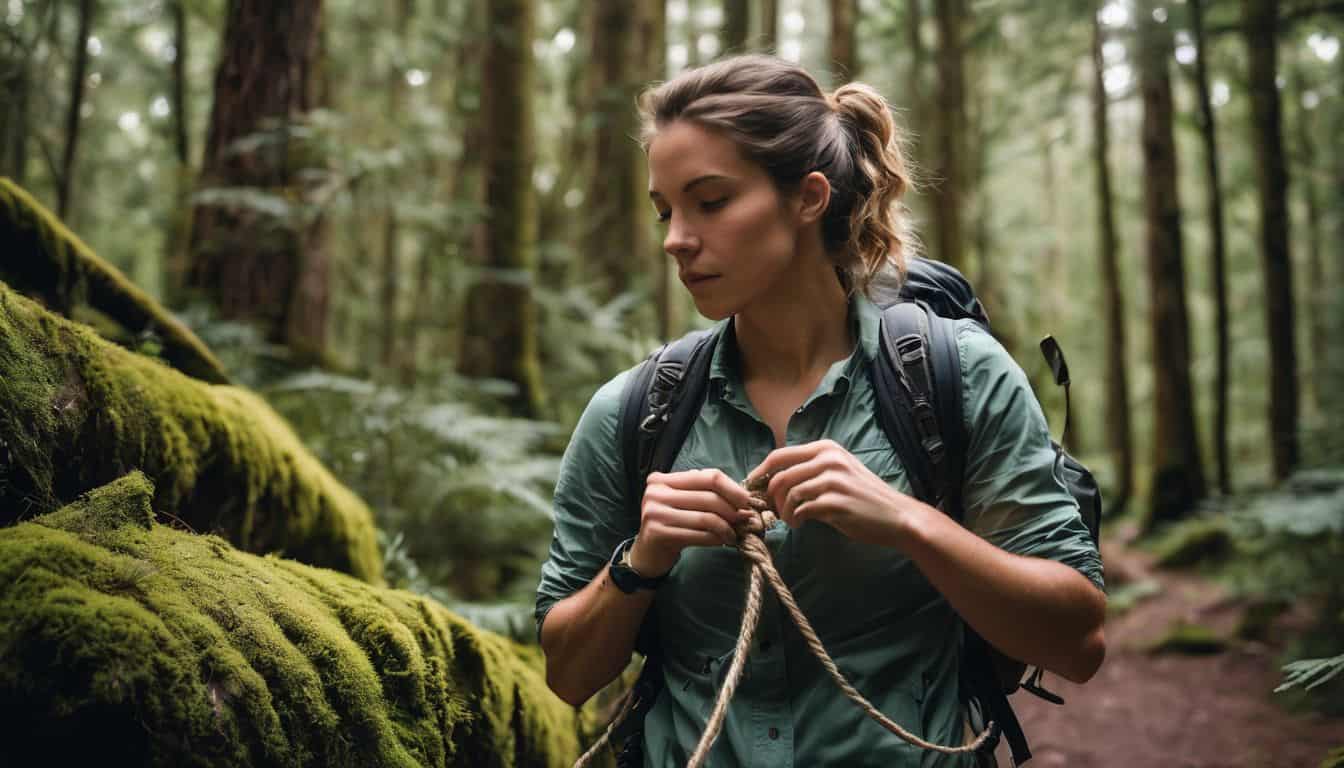Navigating the wilderness is like solving a puzzle. It can be incredibly overwhelming unless you’re armed with the right skills and, of course, a sense of adventure. During my journey as an avid survival enthusiast, I’ve found that mastering basic survival knots has been absolutely crucial in maintaining safety and boosting your outdoor experience.
In this article, we’re going to dive into six essential knots recognized by Bear Grylls himself – tried-and-true helpers mastered not only by him but also countless outdoor enthusiasts around the world.
Are you ready? Let’s unravel this wonderfully knotty mystery together!
Key Takeaways
- Mastering essential knots is crucial for survivalists and outdoor enthusiasts.
- The bowline, double sheet bend, and halter hitch are versatile knots that can excel in various situations.
- These knots provide safety, help build shelters, secure gear, and are invaluable in rescue or emergency scenarios.
- Practice tying these knots to enhance your survival skills and stay prepared for outdoor adventures.
The Most Useful Outdoor & Survival Knots
In this section, I will highlight some of the most essential knots for survivalists. These knots will come in handy during outdoor adventures and emergency situations.
Clove Hitch
The Clove Hitch is a great knot to know for any survivalist. It’s quick and easy to tie around something like a branch or a pole. You can use it in the middle of your rope, too. This knot will hold firm when you pull on both ends of the rope.
But, be careful as it may loosen if you only pull one end. This makes it good for starting lashings or tying an anchor point. Plus, you can adjust the Clove Hitch by sliding it along the rope until it’s where you need it!
Square (or Reef) Knot
The Square (or Reef) Knot is one you should know. It’s a top choice for outdoor tasks. This knot is good for joining two rope ends together. You can make it fast, and it won’t slide or slip.
Yet, don’t use the Square Knot for heavy stuff. Or in places with lots of move arounds. Too much tug could untie it. It can’t hold loads that weigh a lot either. Stick to its simple uses and you’ll find this knot quite handy!
Sheet Bend
The Sheet Bend is a friend to all who love the outdoors. It lets us tie two ropes together, even if they are not the same size or made of different stuff. This knot lends a hand in mending broken lines when we are out in the wild.
It’s an awesome tool for survival because it is easy to untie, even after holding heavy loads. So whether you need to set up a shelter or haul some gear, rely on this useful knot!
Bowline
The Bowline knot is a crucial knot for survivalists, outdoor enthusiasts, and anyone interested in wilderness skills. It’s known as the “king of knots” because it’s versatile and easy to tie.
This knot has many practical applications, whether you’re anchoring equipment, hoisting a bear bag off the ground, or securing gear in rescue operations. One of its greatest strengths is its reliability and strength; it won’t easily come undone when under tension.
Learning how to tie the Bowline knot is an essential skill for anyone venturing into the outdoors or looking to improve their survival techniques.

Double Fisherman’s Knot
The double fisherman’s knot is a very useful knot for survivalists like us. It’s commonly used in climbing and other sports activities. This knot allows you to lengthen your rope, repair damaged ropes or tie together fishing lines.
It’s also known as the double sheet bend and is considered one of the top 10 survival knots that everyone should know. So it’s definitely worth learning how to tie this knot!
Prusik Knot
The Prusik Knot is one of the most useful outdoor and survival knots that every survivalist should know. It’s essential because it allows you to climb and descend ropes with ease. The Prusik Knot works by creating friction between two ropes, allowing you to move up or down while staying securely attached.
With this knot, you can navigate steep slopes, ascend trees, or even rescue someone in an emergency situation. There are also variations of the Prusik Knot that offer different uses and benefits.
Mastering the Prusik Knot will greatly enhance your survival skills and give you more confidence in outdoor activities.
Basics of Essential Knots for Survivalists

Learning the basics of essential knots is crucial for survivalists like us. Knots are important because they help us secure our gear, create temporary shelters, and even assist in rescue situations.
To effectively tie knots, it’s important to understand knot lingo and terminology. There are approximately four thousand knots in the world of safety ropes, but we will focus on a few essential ones that every survivalist should know.
Some of these essential knots include the bowline, double sheet bend, and halter hitch. The bowline knot is great for creating a loop at the end of a rope or securing objects together.
It’s commonly used in activities like rock climbing or setting up tarps. The double sheet bend is useful when you need to join two different types or sizes of ropes together securely.
And finally, the halter hitch is often used to tie animals or heavy loads.
By learning these basic knot tying techniques and practicing them regularly, we can improve our survival skills and be better prepared for outdoor adventures. So let’s get started and master these fundamental knots that will serve us well in various situations!
How to Tie the Bowline Knot
Learn the step-by-step guide to tying a Bowline knot and discover its various useful applications in survival situations.
Examples of when to use a Bowline
In camping, the bowline knot is great for securing tents and tying ropes to trees. If you’re out boating, it can be used to fasten a mooring line to a ring or a post. When sailing or doing maritime activities, the bowline knot comes in handy too.
It’s also useful for creating a fixed eye or loop at the end of a rope. And of course, survivalists and preppers often use the bowline knot for securing gear and making makeshift harnesses.
Step-by-step guide to tying a Bowline
Let me show you how to tie a Bowline knot. This knot is really useful in survival situations. Here’s how you do it:
- Start by forming a loop in the rope, leaving enough space for the end of the rope to pass through.
- Take the end of the rope and pass it up through the loop from underneath.
- Now, bring the end of the rope around behind the standing part (the long part of the rope) and then back down through the loop.
- Pull both ends of the rope tight to secure the knot.
- To untie the Bowline, simply push on its working end (the loose end) and it will come undone easily.
Variations of the Bowline Knot
There are a few variations of the bowline knot that can provide extra options when tying knots. One variation is called the double bowline knot, which creates two loops instead of just one.
This can be useful in certain situations where you need to secure multiple objects or create additional attachment points. Another variation is the Spanish bowline, commonly used by sailors because it’s a very secure knot.
These variations enhance the functionality and versatility of the traditional bowline knot, giving you more options when tying knots in survival situations.
How to Tie the Double Sheet Bend Knot
To tie the Double Sheet Bend Knot, start by creating a loop with the working end of one rope and passing the other rope through it. Then, take the working end of the second rope and wrap it around both ropes twice before bringing it back through itself.
Tighten the knot by pulling on both ends and ensure that the wraps are snugly secured to create a strong bond between the two ropes.
Examples of when to use a Double Sheet Bend
The Double Sheet Bend is a knot that comes in handy in several situations. One example is when you need to fasten a small line to a larger one, especially if the two lines are of different diameters.
Let’s say you’re out camping and need to secure your gear by tying two ropes together – the Double Sheet Bend can do the job efficiently. It’s also useful during emergency situations where you may need to quickly join or connect ropes of different sizes.
Survivalists and outdoor enthusiasts commonly rely on the Double Sheet Bend for its versatility and reliability.
Step-by-step guide to tying a Double Sheet Bend
Here’s how to tie a Double Sheet Bend:
- Fold the thicker rope into a bight (a loop) and hold it in your left hand.
- Take the thinner rope and pass it through the bight from behind, going over the front of the bight and then back under itself.
- Pass the thinner rope back through the loop created by its own standing part, from front to back.
- Make sure both ends of the thinner rope come out on the same side of the knot.
- Hold onto all four ends of the ropes and tighten the knot by pulling them in opposite directions.
How to Tie the Halter Hitch Knot
To tie the Halter Hitch Knot, start by creating a loop with the working end of the rope.
Examples of how to use a Halter Hitch
The Halter Hitch is a handy knot for survivalists. One example of how to use it is when you need to anchor the end of your rope around a tree or table leg. It’s also great for creating a makeshift halter out of a piece of rope, which can be useful if you’re trying to catch horses in an open field or manage them in a pasture.
Additionally, the Halter Hitch can be used to hitch ropes to rods or poles, or even add ropes to existing structures. With this knot, you’ll have the practical skills you need for various rope anchoring methods and pasture management tasks.
Step-by-step guide to tying a Halter Hitch
Tying a Halter Hitch knot is an important skill for survivalists. Here’s how you can do it:
- Start by creating a loop with your rope or cord. Hold the standing end of the rope in one hand and the working end in the other.
- Pass the working end of the rope through the loop, crossing over the standing end.
- Bring the working end around to make another loop behind the first loop.
- Take the working end and pass it through this second loop from underneath.
- Tighten the knot by pulling both ends of the rope in opposite directions until it is secure.
Practice Tying Survival Knots
Learn and perfect your knot tying skills with a variety of essential survival knots including the Trucker’s Hitch, Alpine Butterfly Knot, Prusik Hitch, Munter Hitch, Slip Knot, Canadian Jam, Shear Lash, and Square Lash.
Trucker’s Hitch
The Trucker’s Hitch is an essential knot for survivalists to learn. It’s commonly used in the transportation industry to secure loads on trucks and trailers. This knot is made up of two basic knots, which makes it easy to learn and tie.
The Trucker’s Hitch is a tension hitch that can be used to cinch down and secure anything that can be tied to a line. It’s highly versatile and can be used in various outdoor and emergency situations.
Learning how to tie the Trucker’s Hitch will give you the skills you need to ensure safety, create temporary shelters, and securely fasten gear and equipment when out in the wild or during emergencies.
Alpine Butterfly Knot
The Alpine Butterfly Knot is a really important knot for outdoor activities like mountaineering, camping, hiking, and rock climbing. It’s versatile and can be used in different situations.
One cool thing about the Alpine Butterfly Knot is that it’s symmetrical and can be loaded on either strand of rope. It’s also adjustable, which means you can easily change its size or shape if you need to.
A lot of times, people use the Alpine Butterfly Knot when they want to clip into the middle of a section of rope. It’s a useful knot to know because it gives you flexibility and control in various scenarios.
Prusik Hitch
The Prusik hitch is a really useful knot for survival situations. It’s tied around another rope and can be used to set up shelter, secure gear, or create a rescue line. I find it especially handy when I’m camping, boating, or involved in search and rescue operations.
One great thing about the Prusik hitch is its versatility – you can use it to ascend or descend ropes. Learning this knot is definitely worth it if you’re a survival enthusiast like me!
Munter Hitch
The Munter Hitch is a knot that can be useful for practice when it comes to tying survival knots. Although it’s not one of the essential survival knots mentioned in this article, it’s good to know about different types of hitch knots.
Unfortunately, we don’t have any specific information or tips on how to tie the Munter Hitch in this content. However, if you’re interested in learning more about knot tying techniques and honing your survival knot skills, there are plenty of resources available online and at workshops where you can practice and improve your proficiency with various knots.
Keep practicing and soon enough, you’ll become a master at essential knot types!
Slip Knot
The slip knot is a really useful knot to know. It’s like a noose that tightens when you pull on the end. Survivalists use the slip knot for lots of things, like making animal snares and building shelters.
It can also be used to tie two pieces of rope together. The great thing about the slip knot is that it’s versatile and can be used in different situations. So if you want to be prepared for anything, learning how to tie a slip knot is definitely worth it!
Canadian Jam
The Canadian Jam knot is a useful knot for survival situations. It combines two overhand knots to create a line locker knot. This knot is easy to learn and tie, making it a valuable skill for preppers and outdoor enthusiasts.
The Canadian Jam knot can be used in emergency situations to secure gear, create temporary shelters, or even rescue someone in need. Learning this knot will enhance your survival skills and preparedness for any outdoor adventure or unexpected event.
Shear Lash
The Shear Lash, also known as the Sheer Lash, is a useful survival knot used for tying things together with rope. It’s a lashing technique that can be used as a foundation knot. When practicing survival knots, it’s important to have good cordage on hand.
The Shear Lash is just one of many knots you can practice to improve your survival skills and ability to secure gear and equipment in emergency situations.
Square Lash
The Square Lash knot is really useful for survival skills and bushcraft. It helps to securely bind two or more poles or branches together. This knot is perfect for joining sticks or poles at right angles, which is important when you’re building shelters or structures in the wilderness.
The Square Lash knot works well with Clove Hitches to create a strong and reliable way of tying together poles. By using the Square Lashing method, you can wrap the rope tightly around the poles and then tie them off with multiple wraps and hitches.
With this knot, you can create tripods, lean-tos, and trestles for shelter, cooking, and other activities in nature.
Benefits of Mastering Essential Knots
Mastering essential knots is crucial for survivalists as it ensures safety in outdoor activities, such as camping and backpacking, by providing secure and reliable ways to tie down gear and equipment.
Ensuring safety in outdoor activities
Safety is a top priority when participating in outdoor activities. Learning and mastering essential knots can greatly contribute to ensuring safety during camping, backpacking, or river trips.
Knots play a crucial role in securing tents, tarps, and gear, preventing accidents caused by loose equipment. They also enable the construction of temporary shelters for protection from the elements.
In addition, knowing how to tie different knots allows you to respond effectively in rescue and emergency situations. So whether you’re embarking on an adventure or honing your survival skills, make sure to master essential knots for a safer outdoor experience.
Creating temporary shelters
Learning essential knots is crucial for survivalists, especially when it comes to creating temporary shelters. These knots are important because they help secure the materials needed to construct a shelter, such as ropes and cordage.
By mastering these knot tying techniques, survival enthusiasts can ensure that their shelters are stable and secure, even in challenging outdoor conditions. So whether you’re facing an emergency situation or simply enjoying some outdoor adventure, having the skills to create temporary housing can greatly increase your chances of staying safe and protected.
Securing gear and equipment
Securing gear and equipment is a crucial skill for survivalists. By mastering essential knots, you can ensure that your important items stay in place, even in challenging outdoor conditions.
One essential knot for securing gear is the Bowline knot. This knot creates a strong loop at the end of a rope or line, making it ideal for tying down tarps, tents, or even anchoring boats.
Another helpful knot is the Double Sheet Bend, which allows you to join two ropes of different thicknesses securely. This is handy when you need to extend the length of your rope or combine cords with varying strengths.
Rescue and emergency situations
In rescue and emergency situations, knowing essential knots can be a lifesaver. The Bowline knot, for example, is great for anchoring ropes around objects or people. It’s commonly used in rescue operations, firefighter operations, and high angle rescues.
By mastering these knots, you’ll have the skills needed to secure gear and equipment during emergencies. Plus, they can also help with creating temporary shelters or even holding dressing on a wound if necessary.
So whether you’re facing a survival situation or aiding in search and rescue operations, having knot tying techniques under your belt is crucial.
Additional Resources and Training Materials
Looking for more ways to master essential survival knots? Check out our recommended online tutorials, videos, and knot tying apps. Join survivalist communities and workshops to learn from experienced experts.
Start honing your knot tying skills today!
Online tutorials and videos
I love online tutorials and videos because they provide additional resources and training materials for essential knots for survivalists like me. These videos are great because they show step-by-step demonstrations, making it easier to learn and practice the knots. Here are some reliable sources that offer high-quality tutorials and videos:
- Online instructional videos: These videos provide clear instructions on how to tie essential survivalist knots. They often include helpful tips and variations to master the knot techniques.
- Training resources: Websites dedicated to survival skills offer downloadable guides and manuals with detailed instructions on knot tying. These resources are valuable for learning the knots at your own pace.
- Knot tying tutorials: Many websites and YouTube channels specifically focus on teaching different types of knots. These tutorials break down each step in a simple and easy-to-understand manner.
- Essential knot techniques: Some online platforms offer comprehensive courses on knot tying techniques. These courses cover various types of knots, their uses, and practical applications in outdoor survival scenarios.
- High-quality cordage: Some online stores not only sell rope but also provide video guides on how to tie different types of knots using their specific cords. This ensures that you have the right kind of cordage for practicing these essential knots.
Knot tying apps and guides
I have found some great knot tying apps and guides that can help you improve your survival skills. Here are a few options to consider:
- Knots 3D: This app provides step-by-step instructions and 360-degree views of various knots. It covers over 125 different knots, including essential ones for survival situations.
- Animated Knots: With this app, you can watch animated tutorials that demonstrate how to tie different knots. It offers a wide range of knots for various purposes, from camping to boating.
- The Ashley Book of Knots: Considered the bible of knot tying, this comprehensive guidebook by Clifford W. Ashley is a valuable resource for learning and mastering knots. It includes detailed illustrations and descriptions of thousands of different knots.
- YouTube tutorials: Many survival experts and enthusiasts create helpful videos on YouTube that teach different knot tying techniques. Search for specific knots or channels dedicated to survival skills to find instructional videos.
Joining survivalist communities and workshops
Joining survivalist communities and workshops is a great way to enhance your survival skills and learn how to tie essential knots for different survival situations. As a survival enthusiast, you can connect with like-minded people who share your interest in survivalism. By joining these communities and attending workshops, you can access a wealth of resources and training materials focused on teaching essential knots. This knowledge is crucial for ensuring safety in outdoor activities, creating temporary shelters, securing gear and equipment, and even in rescue and emergency situations. Taking part in these communities and workshops is an opportunity to acquire valuable survivalist knowledge and improve your skills.
Conclusion on Essential Knots for Survivalists
Mastering essential knots is crucial for survivalists and outdoor enthusiasts. By learning just three versatile knots like the bowline, double sheet bend, and halter hitch, you can excel in various situations.
These knots provide safety, help build shelters, secure gear, and are invaluable in rescue or emergency scenarios. So start practicing these knots today and enhance your survival skills! Sign up for our newsletter to receive more tips and tricks for thriving in the great outdoors.
Sign up for our newsletter.
Sign up for our newsletter to receive regular updates on essential survival knots and prepping tips. Our newsletter is packed with useful information, step-by-step guides, and expert advice to help you excel in knot-tying skills.
By joining our community, you will gain access to additional resources such as online tutorials, videos, and knot tying apps that will further enhance your expertise in knotting techniques.
Don’t miss out on this opportunity to stay informed and prepared for any outdoor or survival situation. Sign up today!
FAQs on Essential Knots for Survivalists
1. Why are knots important for survivalists?
Knots are important for survivalists because they can be used to secure shelter, create tools, trap animals, and perform a variety of other essential tasks in emergency situations.
2. What are some essential knots every survivalist should know?
Some essential knots every survivalist should know include the bowline knot (for creating a loop), the square knot (for joining two ropes together), and the clove hitch (for securing objects to poles or trees).
3. How can I learn to tie these essential knots?
You can learn to tie these essential knots by watching online tutorials, reading books on outdoor skills, or even attending workshops or classes specifically focused on knot tying.
4. Can these knots be untied easily once they’re tied?
Yes, these knots can be untied easily once they’re tied by simply pulling on the working end of the rope. It’s important to practice tying and untying them several times before relying on them in real-life situations.
5. Are there any safety precautions I should take when using these knots?
Yes, it’s important to always double-check your knots for security before putting weight or pressure on them. Additionally, make sure you understand how to properly tie each knot and practice them in safe conditions before using them in potentially dangerous situations.





Leave a Reply